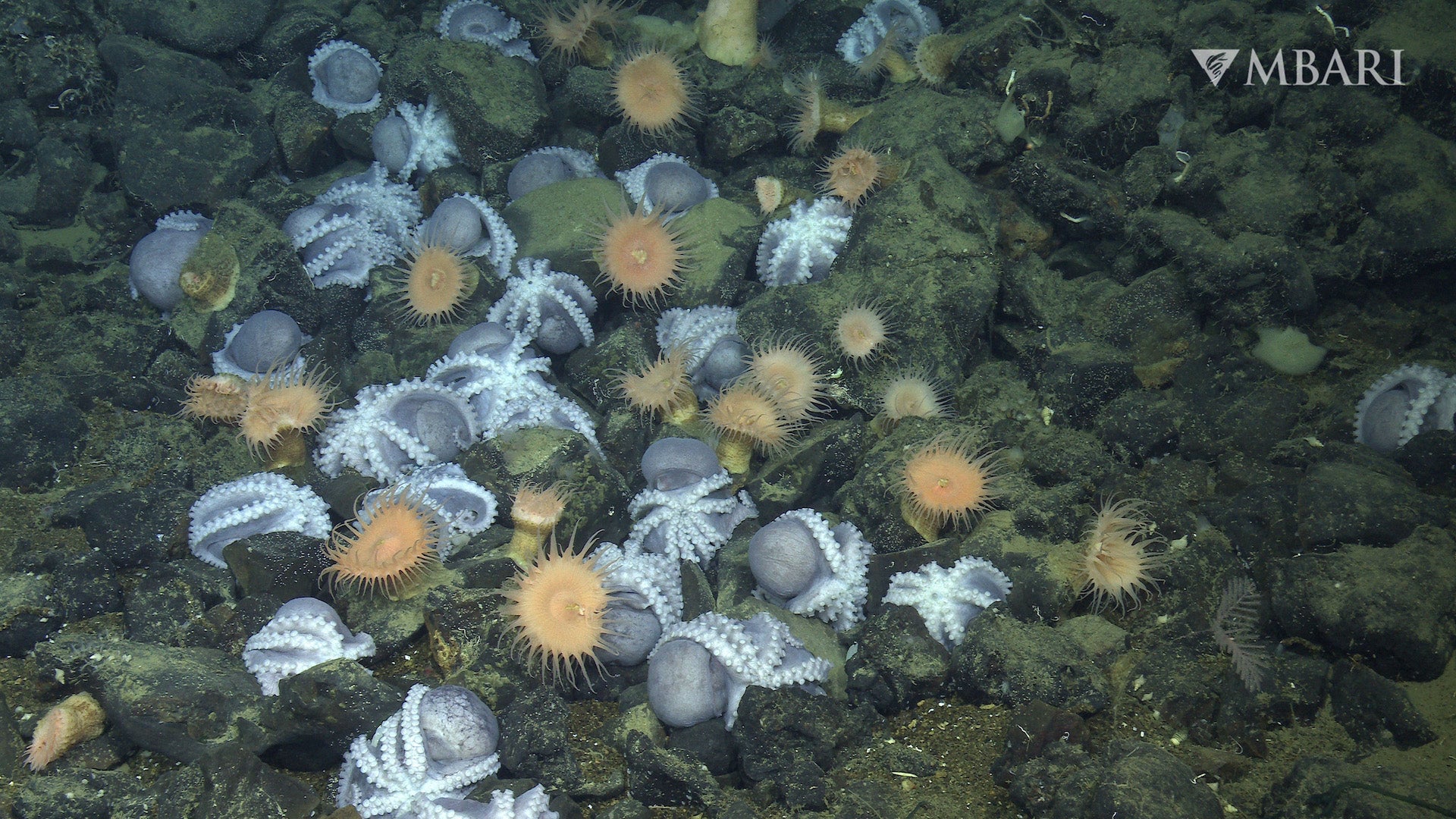
Thousands of deep-sea octopuses gather on the flanks of a seamount off California’s coast. But until recently, scientists weren’t sure why these otherwise solitary animals were congregating. New research suggests they are seeking warmth to help their babies hatch more quickly.
The Davidson Seamount’s “Octopus Garden” was discovered in 2018, when researchers onboard the Ocean Exploration Trust research vessel Nautilus were exploring a rocky spot on the seafloor that was about two miles below the surface. The team spotted a pair of octopuses through a camera on a remotely operated vehicle (ROV), says Amanda Kahn, an ecologist at Moss Landing Marine Laboratories and San Jose State University, who was on the Nautilus that day. After observing the pair for a bit, the operators started to lift the ROV off the rocks to move on—until they saw something unusual. “Up ahead of us were streams of 20 or more octopuses nestled in crevices,” Kahn says.
Octopuses are usually solitary, so it was immediately clear that something strange was happening. The researchers dropped their plans and started to investigate, discovering many more of the pearly-hued, grapefruit-sized octopuses—as well as strange shimmers in the water that suggested the presence of some sort of underwater fluid seeps or springs.
Now, after more than five years and multiple return trips to the Octopus Garden, the researchers estimate that the 1.29-square-mile area may contain more than 20,000 of the cephalopods at any given time. Females of the Muusoctopus robustus—the octopus species found in the garden—hover protectively over their eggs, their arms facing up, ready to swipe away any potential predators.
“This Octopus Garden is by far the largest aggregate of octopuses known anywhere in the world, deep-sea or not,” says James Barry, a benthic ecologist at the Monterey Bay Aquarium Research Institute and leader of a new study, published on Wednesday in Science Advances, that reveals why the animals are gathering. Barry, Kahn and their colleagues found that the octopuses are there to find cozy spots for their nests.
By placing sensors around nests, the researchers discovered that the octopuses were choosing places for their eggs where the temperature hovered between 41 and 51.8 degrees Fahrenheit. By contrast, the surrounding ocean waters are about 34.9 degrees F. Based on patterns seen in other deep-sea octopuses, brooding eggs at 34.9 degrees F would lead to extremely slow development rates, Barry says, with eggs incubating for at least five years and perhaps up to 13 years.
By repeatedly observing the female octopuses and nests in the garden, the research team found that these octopuses were instead hatching their eggs in a little less than two years, Barry says. That’s very close to what established equations would estimate for water temperatures in the 40s, he adds. A quicker incubation period likely means fewer offspring will be lost to predation, parasites or other threats. “It’s a neat sort of accelerator,” Kahn says.
The octopus breeding ground also creates a sort of oasis for other ocean life, the researchers found. Octopus moms die after brooding, and the concentration of octopus bodies in the area injects a source of carbon—a crucial nutrient—into the local ecosystem. “We’re now interested in getting back there and looking at the halo effect of the breeding ground,” Barry says.
The researchers also found a smaller breeding site, which they call the Octocone, about five miles from the Octopus Garden. These sites (and similar nurseries off Costa Rica and Vancouver, British Columbia) are the only ones where this kind of octopus accumulation is known, says Beth Orcutt, a senior research scientist at Bigelow Laboratory for Ocean Sciences in Maine, who was not involved with the Davidson Seamount study but was one of the discoverers of the nursery off Costa Rica. “We predict there should be more,” Orcutt says. “That’s because there are tens of thousands of these small seamounts in the Pacific Ocean, but they just haven’t been explored.”
The new study was unique because the scientists had access to research vessels and ROVs for repeated visits to the site, says Jorge Cortés, a marine biologist at the Center for Research in Marine Sciences and Limnology at the University of Costa Rica, who co-discovered the Costa Rican nursery but was not involved in the new research. Costa Rica depends on international science collaborations for research vessel access, Cortés says, which limits the kinds of studies that can be done. He and his team placed temperature and water-chemistry sensors in the Costa Rica nursery this year, however, and they will return to collect data after six months, potentially shedding more light on another octopus breeding ground.
The warm springs the octopuses at the Davidson Seamount seem to seek are much more subtle features than the dramatic hydrothermal vents that spew out what looks like black or white smoke on the ocean floor. In the case of the Davidson Seamount, it was the octopuses that were noticeable before the warm water, Kahn says.
The Octopus Garden is within the Monterey Bay National Marine Sanctuary, so it is somewhat protected. The researchers say that many other obscure sites in need of conservation may still be out there, however. “There are some very important breeding grounds that are sites we really need to understand and protect,” Barry says.
